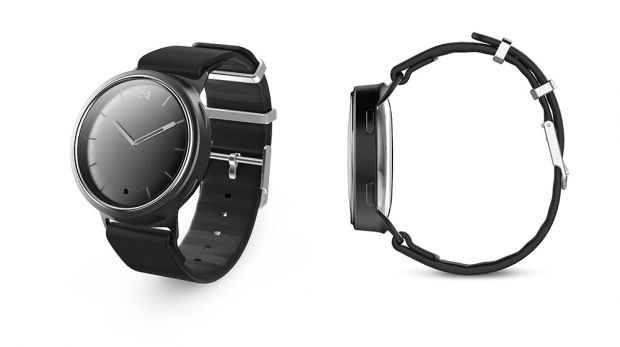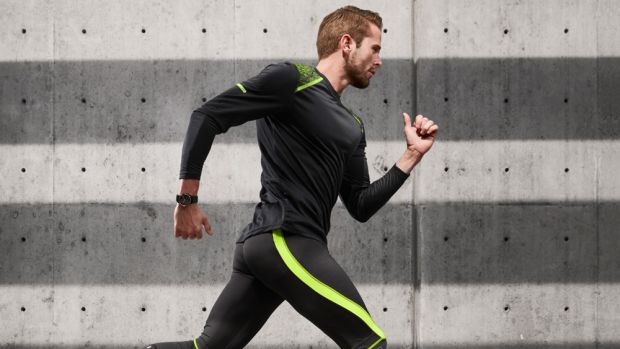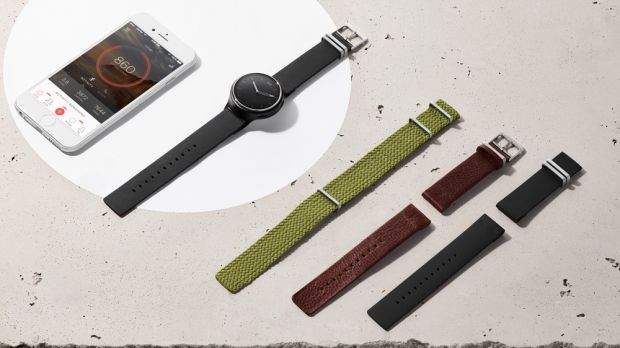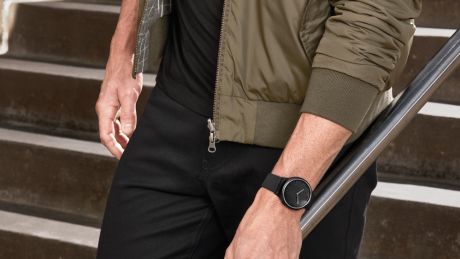Our Verdict
Things we liked Stylish, simple design makes it look just like a watch The Misfit Points system is smarter than simple step tracking, rewarding more strenuous activity The non-rechargeable, replaceable battery means you won’t miss logging something because it’s charging Run tracking is impressively accurate considering there’s no GPS Things we didn’t like The metal bars on the strap are uncomfortable, pinching my arm hairs on occasion The Phase won’t track cycling unless attached to the ankle, which looks weird Additional swim tracking features costs £9.99 extra – a bit much when you’ve already dropped £165 on the tracker There’s a colour-coded dot on the face which is pretty pointless and detracts from the simplicity of the design
You can trust Coach
£165, buy on misfit.com | check price on amazon.co.uk
RECOMMENDED: The Best Fitness Trackers Of 2017
Misfit Phase In-Depth Review

Misfit made its name by producing impressively stylish fitness trackers like the Shine and Ray that didn’t look sporty, so they could be worn with most outfits, and used replaceable rather than rechargeable batteries that removed the hassle of regular charging. It was a refreshing approach that made tracking simple and accessible. The Misfit Phase abides by those principles, but wraps them up in the body of an analogue watch.
Using The Misfit Phase For Step Counting
Misfit trackers do count steps, but they eschew the otherwise ubiquitous 10,000-step goal in favour Misfit Points. Different levels of activity – light, moderate and vigorous – count for different amounts of points. It’s an excellent system that is more in line with NHS activity goals. It means that taking 2,000 steps when running is worth more Misfit Points than 2,000 steps of walking, a distinction that more basic trackers don’t make.
You are still given an overall step count for the day in the app, and when it records running or walking as an activity, you can also see how many steps you took for that activity.
Using The Misfit Phase To Track Activity
The Phase records your activity automatically and categorises it as light, moderate or vigorous. You can then edit it with more detail on what you were actually doing, as long as it was one of the seven options available – running, cycling, swimming, basketball, tennis, football and default (walking). It will also sometimes have a stab at identifying the exact activity itself, with mixed results, but you can correct it afterwards.
The light (walking), moderate (cycling, fast walking), vigorous (running) approach links directly to the Misfit Points earned and while it’s less detailed than other trackers, it makes sense for an overall picture of your activity. It’s easy and quick to understand.
Misfit will also show you how much more activity is required to hit your daily goal. So if you were 328 points towards a daily goal of 1,000, for example, the app says that it will take one hour of walking, 20 minutes of running or 30 minutes of swimming to hit the day’s target.
With no display on the Phase itself, you’ll need to go into the Misfit app to tag activities but you can get a quick look at your overall progress for the day by pressing the upper button on the watch. This sends both watch hands to 12, before they move around the clock until they reach your progress for the day. So 20 past the hour means you’re a third of the way towards your goal.
Using The Misfit Phase For Running

Given that the Phase has no GPS, or even an assisted GPS that pairs with your phone, it’s surprisingly accurate at tracking runs, generally staying within 300m or so of the TomTom Spark 3 GPS watch I used at the same time over runs of 5-7km.
Running is tracked automatically and tagged as vigorous activity. You can also see how many calories you burned on the run and the amount of steps taken. For a basic tracker, the Phase does pretty well with running, but if it’s your main activity and you want to get better at it, you’ll be better served by a tracker that offers more detail, such as pace, using a built-in or assisted GPS.
RECOMMENDED: The Best Fitness Trackers For Marathon Training
Using The Misfit Phase For Cycling
The Phase does track cycling automatically, but only if you wear it on your ankle. While that seemed reasonable with the bracelet-style Misfit Ray or Shine, it feels odd to move a watch from wrist to ankle.
I did try cycling with the Phase on my wrist but it didn’t pick up any activity, so I racked up zero Misfit Points. Other trackers, such as the Fitbit Alta or Charge 2, do record cycling automatically from a wrist position, so it’s a bit of shame the Phase couldn’t manage it.
You can add activities manually in the app, but you won’t be given Points or a calorie count for them. If your main activity is cycling to and from work and you want credit for it, you will have to move the Phase to your ankle – not so bad in the winter when you can keep it covered, but come shorts weather it will inevitably be mistaken for an electronic tag, and you for a ne’er-do-well, at some point.
Using The Misfit Phase For Swimming
Waterproof to 50m, the Phase will track your activity in the pool and give you credit in the form of Misfit Points. Misfit has partnered with Speedo to add swimming features such as lap counting and distance, but it’ll cost you an extra £9.99 (in-app purchase).
They’re useful extra features, but having spent £165 on a tracker, you shouldn’t have to shell out a tenner more for them, especially when swimming is considered so central to your daily target that the Phase tells you how much of it you need to do each day.
RECOMMENDED: The Best Swimming Watches
Using The Misfit Phase For Calorie Counting
Misfit Points are the primary target but you’ll be given details on the calories burned throughout the day and for each activity that is recorded by the Phase. Given the accuracy with which it records runs and walks, the calorie counting is likely to be on point with those activities. The Misfit app can also link to MyFitnessPal to give a dynamic calorie account based on your activity and calorie intake.
Using The Misfit Phase As A Sleep Tracker
Despite its chunky design, the Phase is comfortable enough to wear at night. It tracks sleep pretty reliably, breaking it down into light and deep sleep, as well as any periods in the night when you wake up.
One error it made most nights was to start recording sleep too early if I was awake but not moving, when watching TV or reading for example. I’d check my sleep total in the morning and be amazed at getting ten hours’ rest, before realising and having to subtract a couple from the previous night. Editing the totals is simple, but still, it defeats the point of automatic tracking.
The six-month battery life on the Phase is also useful for sleep monitoring, because you don’t have to charge it at night to track activity in the day. The silent alarm is easy to set and buzzes firmly enough to wake you up; you can also see what time it is set for by pressing twice on the top button on the Phase, a welcome shortcut that means you don’t get a bedtime dose of the dreaded sleep-disrupting blue light.
Using The Misfit App
In keeping with Misfit trackers themselves, the app is clean and simple. The dashboard contains your daily targets for activity and sleep, and you can swipe back for previous days, or scroll down to see more detail on that day’s activities. You can also see how much running, walking or swimming you need to do to hit your daily goal at a glance.
You don't get much detail on any activities tracked, just activity type, distance, calories burned, steps (if relevant) and Misfit Points.
The Misfit app does link with several other popular fitness apps, including MyFitnessPal, Apple Health and Runkeeper, but some big hitters are missed out – notably Strava and Nike+ Run Club.
Using The Misfit Phase As A Smartwatch
The Phase offers some very basic smartwatch-style notifications. It will buzz in response to a call, text and even some apps, including WhatsApp. The small circle on the face also changes colour in response to what kind of notification it is. Generally, I forgot what colour matched up to what notification, and simply got my phone out when the Phase buzzed at me. Considering the coloured circle is the only detail that stops the Phase looking like a regular watch, it’s a wonder Misfit bothered to include it at all.
How Often Do I Need To Charge It?
Misfit aims to make life easy by opting for a non-rechargeable, long-lasting battery in its trackers. The Phase’s battery life is a superb six months, which really does take away the biggest hassle of any fitness tracker. As it’s waterproof too, there’s very little need to ever take it off. The Phase comes with a small plastic tool that’s used to take the back off the watch to replace the coin-style battery when required. Try not to lose it.
Where Can I Wear It Without People Laughing At Me?

Anywhere you can wear a watch. The Phase is a little chunkier than I generally like my watches, but that’s a matter of taste. It’s a very well-designed piece of kit with no indication that it’s a fitness tracker aside from the strange and, to be honest, unnecessary coloured circle.
The only design fault I found with the Phase were the metal bars that hold the silicone strap in place. When my arm was slightly sweaty or wet, they had a nasty tendency to trap arm hairs.
You can also swap the straps to suit personal taste, with a three-pack costing £49.99 on the Misfit website.
Are There Other Trackers I Should Consider Buying?
If you want a fitness tracker that looks like a watch, Withings’ trackers have been the best available for a while, and it’s notable that the Withings Activité Steel comes in substantially cheaper than the Misfit Phase at £119.95 and offers pretty much the same functionality and an eight-month battery life. In the same price bracket, the Activité Steel HR throws a heart rate monitor into the mix.
Both the Phase and the Activité are excellent everyday trackers so when picking between them might come down to how much you like the design of each. That’s if you don’t mind the extra cost of the Misfit. Given the functionality on the Phase is the same as other Misfit trackers, I’d also be tempted by the Ray at £79.99. It doesn’t have a watch face, but it’s beautifully designed and half the price.
If you want a more fitness-focused tracker, both the Fitbit Charge 2 and upcoming Fitbit Alta HR are cheaper than the Phase, but they are very clearly fitness trackers, unlike the Phase, which really does look just like a watch. Aside from that damned coloured circle.

Nick Harris-Fry is a journalist who has been covering health and fitness since 2015. Nick is an avid runner, covering 70-110km a week, which gives him ample opportunity to test a wide range of running shoes and running gear. He is also the chief tester for fitness trackers and running watches, treadmills and exercise bikes, and workout headphones.

